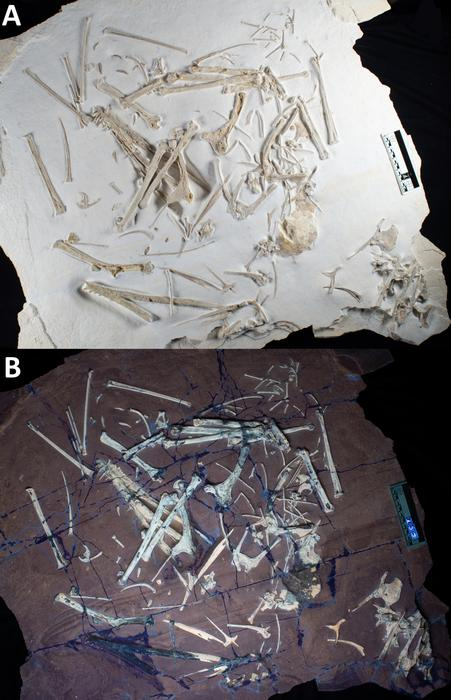An exceptionally preserved fossil fills in an enormous gap in the evolution of pterosaurs, the largest animals capable of flight.
Of all the major reptile orders of the age of dinosaurs, pterosaurs may be the least understood. It’s puzzling enough how they managed to take off while being the largest flying creatures until airplanes became big enough to transport elephants; the limited fossil record makes things worse. Pterosaurs had light bones to enable flight, and these have fossilized very poorly, so our record of these creatures is sparse. When we do find specimens with more than a bone or two, they’re usually crushed flat.
The pterosaur fossils were first recognized as being from flying reptiles around 1800, but for most of that time there has been a vast gap in our knowledge of how they changed over their 160-million-year history. The original version, known as non-pterodactyloids, were human-sized or smaller and never outgrew that. The pterodactyloids that first emerged tens of millions of years later had some species with 10-meter (33-foot) wingspans. Besides size, several features of the body plan differed between these two wings of the family, some of which presumably allowed the extraordinary growth in size.
The first fossils filling in that great gap were not found until 15 years ago, but have helped reveal the order in which crucial steps in the pterosaur transformation took place.
Now a new specimen not only fills in a little more of the intervening time, but has almost every bone preserved in three dimensions, although their locations were unusually shuffled. Although the individual that has become the type specimen for the new species Skiphosoura bavarica is not huge, it provides hints as to how the later giants became possible.

All the bones of the Skiphosoura bavarica type specimen. Remarkably, most have surivived uncrushed, yet they were rearranged and scrambled.
Image credit: René Lauer
The name of the new discovery means “sword tail from Bavaria,” reflecting the fact Skiphosoura had a short, stiff and pointy tail, as if it was carrying a blade around in case of a need to ride to battle. It was found in the Schaudiberg Quarry, in the Solnhofen region, where the original Pterodactylus and other early pterosaur discoveries were made.
Skiphosoura was apparently an innovator in having a short tail, which subsequently became all the rage. More importantly, Skiphosoura shows the beginnings of changes to wing bone ratios that may have helped set the stage for the giant wingspans that followed it. The fact the wingspan of this specimen was 1.75 meters (5.8 feet) across – substantially larger than most pterodactyl predecessors – and may not have been fully grown, speaks to the benefits of the new design.
The early pterosaurs had short heads, necks, and wrist bones to hold their wings, but long tails and fifth toes. When the pterodactyloids emerged from the fossil equivalent of the dark ages all these had reversed. Since these changes were unlikely to occur simultaneously, palaeontologists have been keen to know which came first, and if some opened the door to others.
Like some ancient mythical beast, the first intermediary examples had heads and necks like their descendants, but bodies resembling their ancestors, answering at least part of the question. These were named darwinopterans, after the first discovery, and as a dig at the creationists who like to claim Darwin’s prediction of transitional fossils has not been met (spoiler, it has).
Although many darwinopterans have now been found, they all date to a narrow window of time a little over 160 million years ago and come from one region of China. Besides the question of what was happening elsewhere in the world, one big time gap was now two shorter ones.
A Scottish pterosaur named Dearc has helped fill the gap between the non-pterodactyloids and the darwinopterans, being the oldest pterosaur we know with a head as long as its body.
Now Skiphosoura fills in the later space. It maintains many of Darwinopterus’s features, but shows some modified wing bones. For example, Skiphosoura’s metacarpal bones are considerably longer than those of earlier pterosaurs, while not fully matching the pterodactyloids. On the other hand, the pterodactyloids had a first phalanx longer than the second or third, while Skiphosoura is like every earlier pterosaur in having the reverse. The shape of its fifth toe also matches that of earlier pterosaurs, the darwinopterans included, not the pterodacyloids.
Several of Skiphosoura’s features, including what look like strong claws, suggest it may have been good at climbing, perhaps living in forests, rather than coastal environments like many pterosaurs.
“This is an incredible find. It really helps us piece together how these amazing flying animals lived and evolved,” Dr David Hone of Queen Mary University, London, said in a statement. “Hopefully this study will be the basis for more work in the future on this important evolutionary transition.”
The study is published in Current Biology.
Source Link: New Fossil Reveals Pterosaurs On The Way To Becoming So Pterrifyingly Big